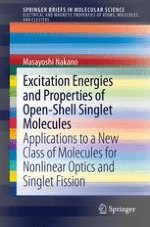2014 | Buch
Excitation Energies and Properties of Open-Shell Singlet Molecules
Applications to a New Class of Molecules for Nonlinear Optics and Singlet Fission
verfasst von: Masayoshi Nakano
Verlag: Springer International Publishing
Buchreihe : SpringerBriefs in Molecular Science
